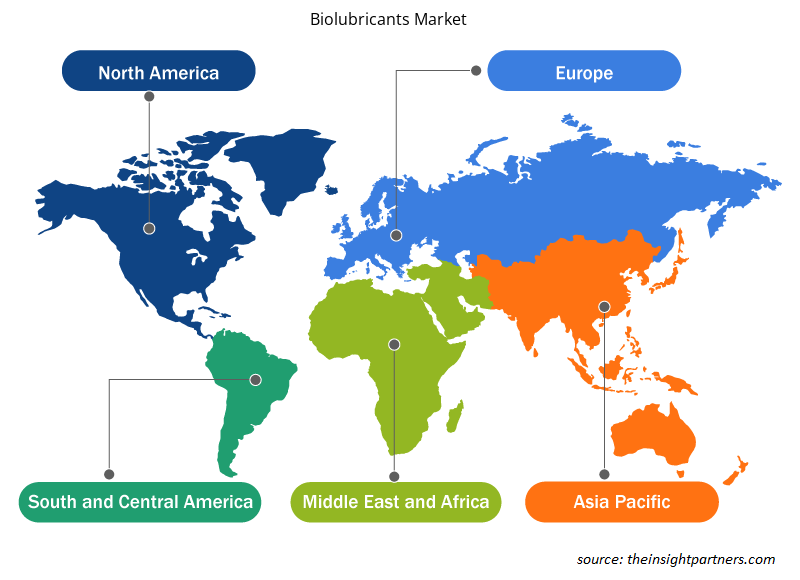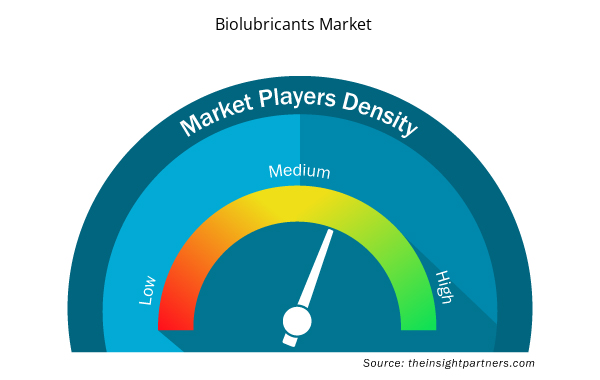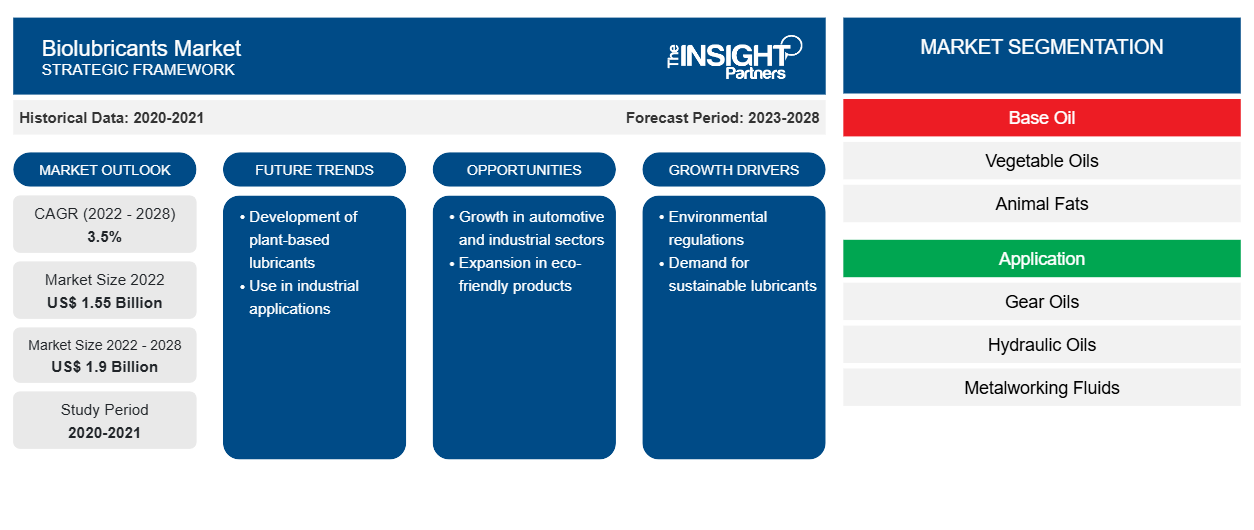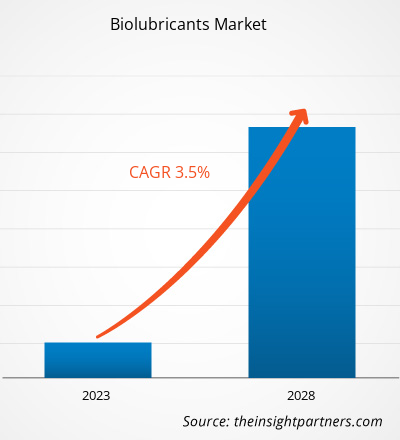Se espera que el mercado de biolubricantes crezca de US$ 1.551,15 millones en 2022 a US$ 1.902,41 millones en 2028; se estima que registrará una CAGR del 3,5% de 2022 a 2028.
Los biolubricantes se elaboran a partir de aceites derivados de vegetales y otros recursos renovables, incluidos productos animales. Los biolubricantes son biodegradables y no tóxicos para los seres humanos y los entornos acuáticos. La biodegradabilidad de los biolubricantes desempeña un papel fundamental en aplicaciones que tienen un alto riesgo de fugas al medio ambiente. Además, los biolubricantes tienen puntos de inflamación más altos, viscosidad constante y menos emisiones de niebla/vapor de aceite y ofrecen mayor seguridad. Los biolubricantes también producen menos emisiones y tienen una adhesión superior a las superficies metálicas. Se utilizan en diversas aplicaciones, incluidos motores, cajas de cambios, sistemas hidráulicos, motosierras, grasas y motores de lanchas rápidas de 2 tiempos. Los biolubricantes se utilizan ampliamente en diversas industrias de uso final, como la automotriz, la marina, la agricultura y la silvicultura, la minería, la construcción, la transmisión de energía, la alimentación y la industria farmacéutica.
El crecimiento del mercado de biolubricantes se atribuye a la creciente demanda de biolubricantes de varias industrias de uso final debido a una mayor conciencia ambiental, leyes ambientales estrictas que exigen el uso de lubricantes ambientalmente aceptables y el alto costo de eliminación de los lubricantes no degradables existentes. En muchos países, existen regulaciones que prohíben el uso de lubricantes a base de aceite mineral en las vías navegables interiores. Dichas regulaciones están impulsando la demanda de biolubricantes para diversas aplicaciones. Además, dado que los biolubricantes son limpios y no tóxicos, su uso ha sido obligatorio en aplicaciones altamente sensibles como la silvicultura y la marina en algunos países de todo el mundo. En aplicaciones marinas, los biolubricantes se utilizan en diferentes secciones y procesos de contenedores, flotas de carga, petroleros y otros barcos con fines de lubricación. Los biolubricantes marinos consisten en aceites de motor, aceites hidráulicos, aceites para compresores, aceites para guías deslizantes, aceites para engranajes, aceites de transferencia de calor, grasas, aceites para turbinas y otros. Además, el crecimiento del comercio internacional marítimo mundial ha impulsado la demanda de biolubricantes, ya que tienen una alta eficiencia y una baja capacidad de emisión. Por lo tanto, el mayor uso de biolubricantes de la industria marina ofrecerá oportunidades lucrativas para el mercado de biolubricantes durante el período de pronóstico.
Personalice este informe según sus necesidades
Obtendrá personalización en cualquier informe, sin cargo, incluidas partes de este informe o análisis a nivel de país, paquete de datos de Excel, así como también grandes ofertas y descuentos para empresas emergentes y universidades.
- Obtenga las principales tendencias clave del mercado de este informe.Esta muestra GRATUITA incluirá análisis de datos, desde tendencias del mercado hasta estimaciones y pronósticos.
Perspectivas del mercado
La creciente demanda de la industria automotriz impulsa el crecimiento del mercado de biolubricantes
En la industria automotriz y del transporte se utilizan aceites de motor, líquidos de transmisión, aceites para cajas de cambios, líquidos hidráulicos y de frenos, y otros aceites para automóviles. Los biolubricantes se utilizan como medios antifricción y absorbentes del calor y permiten un funcionamiento suave y fiable, reduciendo los riesgos de fallos frecuentes que ayudan a mejorar la durabilidad y el ciclo de vida del vehículo. Los lubricantes para automóviles se utilizan para reducir la fricción y moderar el calor que se produce cuando dos superficies están en contacto mutuo. Además, los aceites de motor de base biológica muestran una mayor tasa de biodegradación inherente, una baja toxicidad para los organismos acuáticos y niveles muy bajos de bioacumulación. Además, sustituir los aceites a base de hidrocarburos por productos biodegradables es una de las formas de reducir los efectos adversos de los lubricantes en el ecosistema. Con la creciente presión regulatoria para mejorar la eficiencia del combustible de los vehículos y reducir las emisiones de gases de efecto invernadero, se ha producido un notable desarrollo en las formulaciones de lubricantes de aceite. Estos factores están impulsando la demanda de biolubricantes en la industria automotriz.
Perspectivas sobre el petróleo base
El mercado de los biolubricantes, basado en el aceite base, se segmenta en aceites vegetales, grasas animales y otros. El segmento de aceites vegetales tuvo la mayor participación del mercado en 2022. Los aceites vegetales son alternativas preferidas a los aceites minerales para las bases de lubricantes debido a ciertas propiedades inherentes, que incluyen alta viscosidad, alto rango de ebullición y biodegradabilidad. Los ácidos grasos del aceite se pueden modificar químicamente para formar ésteres de alto peso molecular, que pueden sustituir a los lubricantes convencionales a base de aceite mineral. Se espera que estos factores impulsen el crecimiento del mercado del segmento de aceites vegetales.
Entre los actores clave que operan en el mercado de los biolubricantes se encuentran Emery Oleochemicals LLC, Fuchs Petrolub SE, Carl Bechem GmbH, PANOLIN AG, Renewable Lubricants Inc, TotalEnergies SE, Shell Plc, RSC Bio Solutions LLC, Crevier Group Inc y Kluber Lubrication GmbH & Co KG. Los principales actores adoptan estrategias como fusiones y adquisiciones y lanzamientos de productos para expandir su presencia geográfica y su base de consumidores.
Perspectivas regionales del mercado de biolubricantes
Los analistas de Insight Partners explicaron en detalle las tendencias y los factores regionales que influyen en el mercado de biolubricantes durante el período de pronóstico. Esta sección también analiza los segmentos y la geografía del mercado de biolubricantes en América del Norte, Europa, Asia Pacífico, Oriente Medio y África, y América del Sur y Central.

- Obtenga los datos regionales específicos para el mercado de biolubricantes
Alcance del informe de mercado de biolubricantes
| Atributo del informe | Detalles |
|---|---|
| Tamaño del mercado en 2022 | 1.550 millones de dólares estadounidenses |
| Tamaño del mercado en 2028 | 1.900 millones de dólares estadounidenses |
| CAGR global (2022-2028) | 3,5% |
| Datos históricos | 2020-2021 |
| Período de pronóstico | 2023-2028 |
| Segmentos cubiertos | Por aceite base
|
| Regiones y países cubiertos | América del norte
|
| Líderes del mercado y perfiles de empresas clave |
|
Densidad de actores del mercado de biolubricantes: comprensión de su impacto en la dinámica empresarial
El mercado de biolubricantes está creciendo rápidamente, impulsado por la creciente demanda de los usuarios finales debido a factores como la evolución de las preferencias de los consumidores, los avances tecnológicos y una mayor conciencia de los beneficios del producto. A medida que aumenta la demanda, las empresas amplían sus ofertas, innovan para satisfacer las necesidades de los consumidores y aprovechan las tendencias emergentes, lo que impulsa aún más el crecimiento del mercado.
La densidad de actores del mercado se refiere a la distribución de las empresas o firmas que operan dentro de un mercado o industria en particular. Indica cuántos competidores (actores del mercado) están presentes en un espacio de mercado determinado en relación con su tamaño o valor total de mercado.
Las principales empresas que operan en el mercado de Biolubricantes son:
- Oleoquímicos Emery LLC
- Fuchs Petrolub SE
- Carl Bechem GmbH
- Panolina AG
- Lubricantes renovables Inc.
Descargo de responsabilidad : Las empresas enumeradas anteriormente no están clasificadas en ningún orden particular.

- Obtenga una descripción general de los principales actores clave del mercado de biolubricantes
Informe Destacado
- Tendencias progresivas en la industria de los biolubricantes para ayudar a los actores a desarrollar estrategias efectivas a largo plazo
- Estrategias de crecimiento empresarial adoptadas por las empresas para asegurar el crecimiento en los mercados desarrollados y en desarrollo
- Análisis cuantitativo del mercado mundial de biolubricantes de 2020 a 2028
- Estimación de la demanda de biolubricantes en diversas industrias
- Análisis de las cinco fuerzas de Porter para ilustrar la eficacia de los compradores y proveedores que operan en la industria de los biolubricantes
- Desarrollos recientes para comprender el escenario competitivo del mercado y la demanda de biolubricantes
- Tendencias y perspectivas del mercado y factores que rigen el crecimiento del mercado de biolubricantes
- Estrategias esclarecedoras que apuntalan el interés comercial en el crecimiento del mercado, ayudando en el proceso de toma de decisiones
- Tamaño del mercado de biolubricantes en varios nodos del mercado
- Descripción detallada y segmentación del mercado, así como su dinámica industrial.
- Tamaño del mercado de biolubricantes en varias regiones con oportunidades de crecimiento prometedoras
El "Pronóstico del mercado de biolubricantes hasta 2028" es un estudio especializado y profundo de la industria de productos químicos y materiales, que se centra en el análisis de las tendencias del mercado de biolubricantes. El informe tiene como objetivo proporcionar una descripción general del mercado con una segmentación detallada. El mercado de biolubricantes está segmentado en función del aceite base, la aplicación, el uso final y la geografía. Según el aceite base, el mercado se segmenta en aceites vegetales, grasas animales y otros. Según la aplicación, el mercado se segmenta en aceites para engranajes , aceites hidráulicos, fluidos para trabajar metales, grasas y otros. Por uso final, el mercado de biolubricantes se segmenta en automoción, industrial, marino, agricultura y silvicultura, y otros. El mercado está segmentado en cinco regiones principales: América del Norte, Europa, Asia Pacífico, Oriente Medio y África, y América del Sur y Central. En 2022, Europa dominó el mercado de biolubricantes. Se espera que Asia Pacífico registre la CAGR más alta del mercado durante el período de pronóstico. Factores como las crecientes preocupaciones ambientales y el aumento de los costos del petróleo crudo están impulsando la demanda de biolubricantes en Europa. La demanda de biolubricantes en Asia Pacífico es directamente proporcional a la industrialización y la producción de vehículos en la región. Las crecientes actividades de construcción regionales y los sectores industrial y automotriz aceleran el crecimiento del mercado.
- Análisis histórico (2 años), año base, pronóstico (7 años) con CAGR
- Análisis PEST y FODA
- Tamaño del mercado Valor/volumen: global, regional, nacional
- Industria y panorama competitivo
- Conjunto de datos de Excel



Report Coverage
Revenue forecast, Company Analysis, Industry landscape, Growth factors, and Trends

Segment Covered
This text is related
to segments covered.

Regional Scope
North America, Europe, Asia Pacific, Middle East & Africa, South & Central America

Country Scope
This text is related
to country scope.
Preguntas frecuentes
The major driver for the growth of the biolubricants market is the growing demand for biolubricants from various end-use industries due to increased environmental consciousness, strict environmental laws mandating the use of environmentally acceptable lubricants, and the high disposal expense of the existing non-degradable lubricants. In many countries, there are regulations that forbid the use of mineral oil-based lubricants around inland waterways. Such regulations are driving the demand for biolubricants for various applications. These factors are driving the biolubricants market growth.
During the forecast period, marine is expected to be the fastest-growing segment. Biolubricants significantly improve machine performance, minimize environmental impact, and are safe and convenient for marine applications. Synthetic lubricants lost from marine vessels and machinery (not accidental spills) enter the aquatic ecosystem, where severe damage could take place. Hence the usage of ecosystem-friendly and biodegradable marine lubricants is on the rise. In addition, stringent regulations imposed by various governments are encouraging the application of biolubricants in the marine industry. These factors are expected to boost the growth of the marine segment in the biolubricants market demand during the forecast period.
During the forecast period, the hydraulic oils segment is expected to be the fastest-growing segment. Bio-based hydraulic oils inherently have a high viscosity index, which cuts the cost of additional viscosity improvers. Biodegradable fluids are increasingly used in hydraulic equipment, especially in sensitive environments such as food processing plants, water/wastewater, and pharmaceutical processing. These factors are expected to accelerate the growth of the hydraulic oils segment of the biolubricants market.
In 2022, the vegetable oil segment held the largest market share. Vegetable oils are preferred alternatives to mineral oils for lubricant base stocks because of certain inherent properties, including high viscosity, high boiling range and biodegradability. Fatty acids present in the oil can be chemically modified to form high molecular weight esters, which can substitute conventional mineral oil-based lubricants. These factors led to the dominance of the vegetable oils segment in 2021.
Some of the major players operating in the biolubricants market are Emery Oleochemicals LLC, Fuchs Petrolub SE, Carl Bechem GmbH, PANOLIN AG, Renewable Lubricants Inc, TotalEnergies SE, Shell Plc, RSC Bio Solutions LLC, Crevier Group Inc, and Kluber Lubrication GmbH & Co KG.
In 2022, Europe accounted for the largest share of the global biolubricants market. Various regulations imposed by the European Union have encouraged the consumption of biolubricants due to their environment-friendly properties. The factors such as growing environmental concerns, an increase in the cost of crude oil, and the growing automotive industry of the region led to the dominance of Europe in 2021.
Trends and growth analysis reports related to Chemicals and Materials : READ MORE..
The List of Companies - Biolubricants Market
- Emery Oleochemicals LLC
- Fuchs Petrolub SE
- Carl Bechem GmbH
- PANOLIN AG
- Renewable Lubricants Inc
- TotalEnergies SE
- Shell Plc
- RSC Bio Solutions LLC
- Crevier Group Inc
- Kluber Lubrication GmbH & Co KG
The Insight Partners performs research in 4 major stages: Data Collection & Secondary Research, Primary Research, Data Analysis and Data Triangulation & Final Review.
- Data Collection and Secondary Research:
As a market research and consulting firm operating from a decade, we have published and advised several client across the globe. First step for any study will start with an assessment of currently available data and insights from existing reports. Further, historical and current market information is collected from Investor Presentations, Annual Reports, SEC Filings, etc., and other information related to company’s performance and market positioning are gathered from Paid Databases (Factiva, Hoovers, and Reuters) and various other publications available in public domain.
Several associations trade associates, technical forums, institutes, societies and organization are accessed to gain technical as well as market related insights through their publications such as research papers, blogs and press releases related to the studies are referred to get cues about the market. Further, white papers, journals, magazines, and other news articles published in last 3 years are scrutinized and analyzed to understand the current market trends.
- Primary Research:
The primarily interview analysis comprise of data obtained from industry participants interview and answers to survey questions gathered by in-house primary team.
For primary research, interviews are conducted with industry experts/CEOs/Marketing Managers/VPs/Subject Matter Experts from both demand and supply side to get a 360-degree view of the market. The primary team conducts several interviews based on the complexity of the markets to understand the various market trends and dynamics which makes research more credible and precise.
A typical research interview fulfils the following functions:
- Provides first-hand information on the market size, market trends, growth trends, competitive landscape, and outlook
- Validates and strengthens in-house secondary research findings
- Develops the analysis team’s expertise and market understanding
Primary research involves email interactions and telephone interviews for each market, category, segment, and sub-segment across geographies. The participants who typically take part in such a process include, but are not limited to:
- Industry participants: VPs, business development managers, market intelligence managers and national sales managers
- Outside experts: Valuation experts, research analysts and key opinion leaders specializing in the electronics and semiconductor industry.
Below is the breakup of our primary respondents by company, designation, and region:

Once we receive the confirmation from primary research sources or primary respondents, we finalize the base year market estimation and forecast the data as per the macroeconomic and microeconomic factors assessed during data collection.
- Data Analysis:
Once data is validated through both secondary as well as primary respondents, we finalize the market estimations by hypothesis formulation and factor analysis at regional and country level.
- Macro-Economic Factor Analysis:
We analyse macroeconomic indicators such the gross domestic product (GDP), increase in the demand for goods and services across industries, technological advancement, regional economic growth, governmental policies, the influence of COVID-19, PEST analysis, and other aspects. This analysis aids in setting benchmarks for various nations/regions and approximating market splits. Additionally, the general trend of the aforementioned components aid in determining the market's development possibilities.
- Country Level Data:
Various factors that are especially aligned to the country are taken into account to determine the market size for a certain area and country, including the presence of vendors, such as headquarters and offices, the country's GDP, demand patterns, and industry growth. To comprehend the market dynamics for the nation, a number of growth variables, inhibitors, application areas, and current market trends are researched. The aforementioned elements aid in determining the country's overall market's growth potential.
- Company Profile:
The “Table of Contents” is formulated by listing and analyzing more than 25 - 30 companies operating in the market ecosystem across geographies. However, we profile only 10 companies as a standard practice in our syndicate reports. These 10 companies comprise leading, emerging, and regional players. Nonetheless, our analysis is not restricted to the 10 listed companies, we also analyze other companies present in the market to develop a holistic view and understand the prevailing trends. The “Company Profiles” section in the report covers key facts, business description, products & services, financial information, SWOT analysis, and key developments. The financial information presented is extracted from the annual reports and official documents of the publicly listed companies. Upon collecting the information for the sections of respective companies, we verify them via various primary sources and then compile the data in respective company profiles. The company level information helps us in deriving the base number as well as in forecasting the market size.
- Developing Base Number:
Aggregation of sales statistics (2020-2022) and macro-economic factor, and other secondary and primary research insights are utilized to arrive at base number and related market shares for 2022. The data gaps are identified in this step and relevant market data is analyzed, collected from paid primary interviews or databases. On finalizing the base year market size, forecasts are developed on the basis of macro-economic, industry and market growth factors and company level analysis.
- Data Triangulation and Final Review:
The market findings and base year market size calculations are validated from supply as well as demand side. Demand side validations are based on macro-economic factor analysis and benchmarks for respective regions and countries. In case of supply side validations, revenues of major companies are estimated (in case not available) based on industry benchmark, approximate number of employees, product portfolio, and primary interviews revenues are gathered. Further revenue from target product/service segment is assessed to avoid overshooting of market statistics. In case of heavy deviations between supply and demand side values, all thes steps are repeated to achieve synchronization.
We follow an iterative model, wherein we share our research findings with Subject Matter Experts (SME’s) and Key Opinion Leaders (KOLs) until consensus view of the market is not formulated – this model negates any drastic deviation in the opinions of experts. Only validated and universally acceptable research findings are quoted in our reports.
We have important check points that we use to validate our research findings – which we call – data triangulation, where we validate the information, we generate from secondary sources with primary interviews and then we re-validate with our internal data bases and Subject matter experts. This comprehensive model enables us to deliver high quality, reliable data in shortest possible time.


 Obtenga una muestra gratuita de este informe
Obtenga una muestra gratuita de este informe